英语状语从句的用法总结
- 格式:docx
- 大小:18.78 KB
- 文档页数:2

英语状语从句归纳总结英语状语从句是英语语法中的一个重要部分,它可以用来修饰句子中的主谓宾成分,提供更多的信息和细节。
在学习英语状语从句时,需要掌握从句的类型和用法,以下是一些常见的英语状语从句类型及其用法。
1. 时间状语从句时间状语从句用来表示某个动作发生的时间或顺序。
一些常用的时间状语从句包括:when, while, as, after, before, since, until 等。
例如:- When I was young, I used to play basketball with my friends.(当我年轻时,我曾经和我的朋友们一起打篮球。
)- While I was cooking dinner, the phone rang.(当我在做晚饭的时候,电话响了。
)- After I finish this project, I will take a break.(当我完成这个项目后,我会休息一下。
)2. 地点状语从句地点状语从句用来表示某个动作发生的地点。
一些常用的地点状语从句包括:where, wherever, anywhere, everywhere等。
例如:- She always knows where her keys are.(她总是知道她的钥匙在哪里。
)- Wherever he goes, he takes his laptop with him.(无论他去哪里,他都带着他的笔记本电脑。
)3. 原因状语从句原因状语从句用来表示某个动作发生的原因。
一些常用的原因状语从句包括:because, since, as, now that等。
例如:- Because it was raining, we decided to stay indoors.(因为下雨了,我们决定呆在室内。
)- Since you didn't like the movie, we can watch something else.(既然你不喜欢这部电影,我们可以看其他的。


初中英语知识点归纳状语从句的分类和用法状语从句是英语语法中重要的一部分,它用来修饰主句的动作或描述情况的,在句子中起着状语的作用。
状语从句分为时间状语从句、条件状语从句、原因状语从句、目的状语从句、结果状语从句、方式状语从句和比较状语从句等。
下面将对初中英语中常见的状语从句分类和用法进行归纳。
一、时间状语从句时间状语从句用来表示动作或事件发生的时间,包括连词when (当...时候),while (在...时候),before (在...之前),after (在...之后),as (当),since (自从),until (直到)等。
时间状语从句一般放在主句之前或者之后。
例如:- When I was young, I used to play soccer with my friends. (当我年轻的时候,我常常和朋友们踢足球。
)- After she finished her homework, she went to bed. (她完成作业之后,去睡觉了。
)二、条件状语从句条件状语从句用来表示主句动作的条件或前提,包括连词if (如果),unless (除非),in case (以防),as long as (只要),provided/providing (只要)等。
条件状语从句一般放在主句之前。
例如:- If it rains tomorrow, we will stay at home. (如果明天下雨,我们就在家呆着。
)- Unless you work hard, you won't pass the exam. (除非你努力学习,否则你就不能通过考试。
)三、原因状语从句原因状语从句用来表示主句动作或情况的原因,包括连词because (因为),as (因为),since (因为),for (因为),now that (既然)等。
原因状语从句一般放在主句之前。
例如:- Because it was raining, we stayed at home. (因为下雨,我们呆在家里。
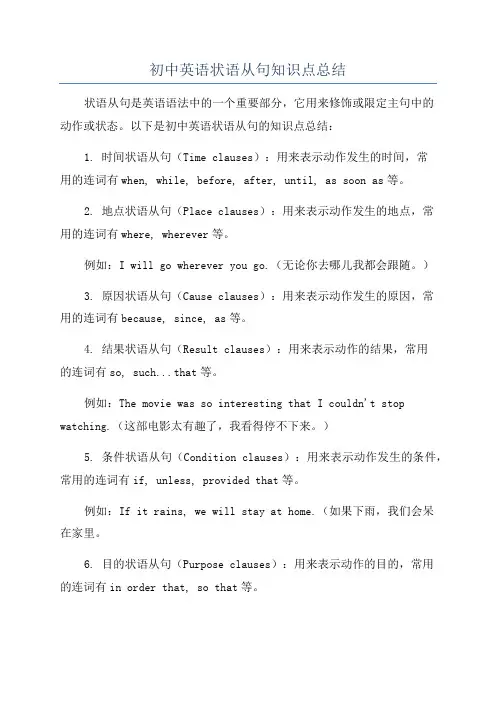
初中英语状语从句知识点总结状语从句是英语语法中的一个重要部分,它用来修饰或限定主句中的动作或状态。
以下是初中英语状语从句的知识点总结:1. 时间状语从句(Time clauses):用来表示动作发生的时间,常用的连词有when, while, before, after, until, as soon as等。
2. 地点状语从句(Place clauses):用来表示动作发生的地点,常用的连词有where, wherever等。
例如:I will go wherever you go.(无论你去哪儿我都会跟随。
)3. 原因状语从句(Cause clauses):用来表示动作发生的原因,常用的连词有because, since, as等。
4. 结果状语从句(Result clauses):用来表示动作的结果,常用的连词有so, such...that等。
例如:The movie was so interesting that I couldn't stop watching.(这部电影太有趣了,我看得停不下来。
)5. 条件状语从句(Condition clauses):用来表示动作发生的条件,常用的连词有if, unless, provided that等。
例如:If it rains, we will stay at home.(如果下雨,我们会呆在家里。
6. 目的状语从句(Purpose clauses):用来表示动作的目的,常用的连词有in order that, so that等。
例如:I bought a new notebook so that I can take notes in class.(我买了一个新笔记本,这样我可以在课堂上记笔记。
)7. 方式状语从句(Manner clauses):用来表示动作发生的方式,常用的连词有as, as if, as though等。
例如:He speaks as if he knows everything.(他说话的样子就像他什么都知道。
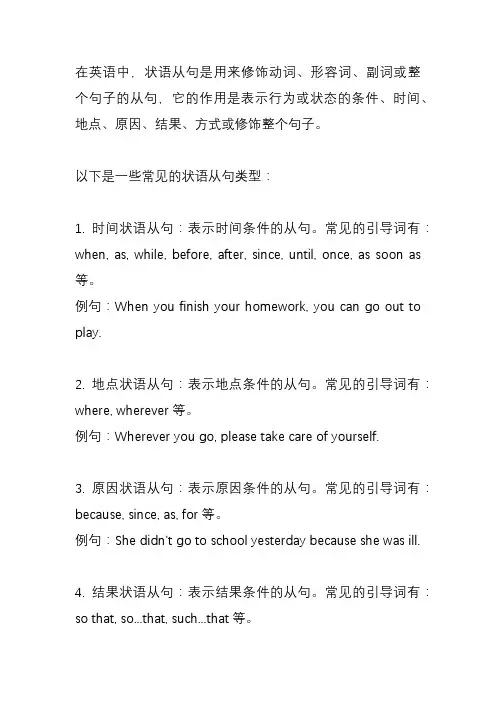
在英语中,状语从句是用来修饰动词、形容词、副词或整个句子的从句,它的作用是表示行为或状态的条件、时间、地点、原因、结果、方式或修饰整个句子。
以下是一些常见的状语从句类型:1. 时间状语从句:表示时间条件的从句。
常见的引导词有:when, as, while, before, after, since, until, once, as soon as 等。
例句:When you finish your homework, you can go out to play.2. 地点状语从句:表示地点条件的从句。
常见的引导词有:where, wherever等。
例句:Wherever you go, please take care of yourself.3. 原因状语从句:表示原因条件的从句。
常见的引导词有:because, since, as, for等。
例句:She didn't go to school yesterday because she was ill.4. 结果状语从句:表示结果条件的从句。
常见的引导词有:so that, so...that, such...that等。
例句:She worked hard so that she could pass the exam.5. 方式状语从句:表示行为方式的从句。
常见的引导词有:as, as if, as though等。
例句:He treated his mother as if she were a stranger.6. 条件状语从句:表示条件假设的从句。
常见的引导词有:if, unless, as long as等。
例句:If it doesn't rain tomorrow, we will go for a picnic.总之,状语从句是英语语法中的一个重要部分,掌握好状语从句的用法可以帮助我们更好地理解和运用英语。
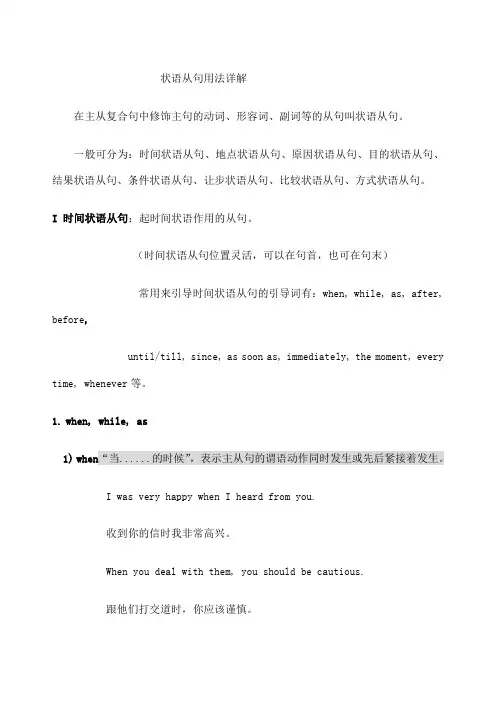
状语从句用法详解在主从复合句中修饰主句的动词、形容词、副词等的从句叫状语从句。
一般可分为:时间状语从句、地点状语从句、原因状语从句、目的状语从句、结果状语从句、条件状语从句、让步状语从句、比较状语从句、方式状语从句。
I 时间状语从句:起时间状语作用的从句。
(时间状语从句位置灵活,可以在句首,也可在句末)常用来引导时间状语从句的引导词有:when, while, as, after, before,until/till, since, as soon as, immediately, the moment, every time, whenever等。
1.when, while, as1) when“当......的时候”,表示主从句的谓语动作同时发生或先后紧接着发生。
I was very happy when I heard from you.收到你的信时我非常高兴。
When you deal with them, you should be cautious.跟他们打交道时,你应该谨慎。
when引导时间状语从句中的谓语动词可以用非延续性动词,也可用延续性动词。
When I was young, I went to town myself.当我还年轻时,我自己独自去城里。
(延续性动词)When I lived in country, I used to carry some water for him.我住在农村时,常常为他担水。
(延续性动词)When he received the letter, he'll tell us.当他接到信后,他会告诉我们的。
(非延续性动词)When the fire broke out, all the students were sleeping soundly.火灾发生时,所有的学生正在熟睡。
(非延续性动词)注意:当when引导的时间状语从句为系表结构,而且其主语和主句的主语一致,其表语又是一个名词时,就可以用由as引导的省略句来代替when引导的从句。
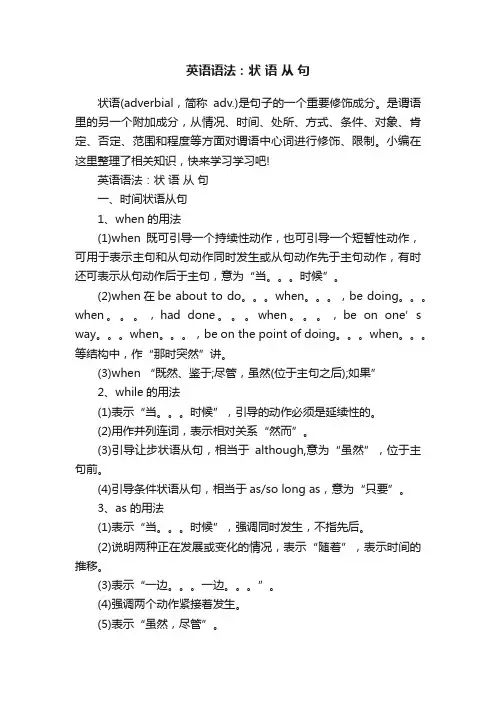
英语语法:状语从句状语(adverbial,简称adv.)是句子的一个重要修饰成分。
是谓语里的另一个附加成分,从情况、时间、处所、方式、条件、对象、肯定、否定、范围和程度等方面对谓语中心词进行修饰、限制。
小编在这里整理了相关知识,快来学习学习吧!英语语法:状语从句一、时间状语从句1、when的用法(1)when既可引导一个持续性动作,也可引导一个短暂性动作,可用于表示主句和从句动作同时发生或从句动作先于主句动作,有时还可表示从句动作后于主句,意为“当。
时候”。
(2)when在be about to do。
when。
,be doing。
when。
,had done。
when。
,be on one’s way。
when。
,be on the point of doing。
when。
等结构中,作“那时突然”讲。
(3)when “既然、鉴于;尽管,虽然(位于主句之后);如果”2、while的用法(1)表示“当。
时候”,引导的动作必须是延续性的。
(2)用作并列连词,表示相对关系“然而”。
(3)引导让步状语从句,相当于although,意为“虽然”,位于主句前。
(4)引导条件状语从句,相当于as/so long as,意为“只要”。
3、as 的用法(1)表示“当。
时候”,强调同时发生,不指先后。
(2)说明两种正在发展或变化的情况,表示“随着”,表示时间的推移。
(3)表示“一边。
一边。
”。
(4)强调两个动作紧接着发生。
(5)表示“虽然,尽管”。
(6)其他含义“正如,正像”,“作为”,“由于,因为”。
4、before的用法(1)一般意为“在。
之前”“。
才”,“。
就”“还没有。
”“免得”“不知不觉”“宁可,宁愿”,“否则,要不然”。
(2)It + will be/was + 时间段+before+一般现在时/一般过去时。
在肯定句中,意为“多长时间之后才”;在否定句中,意为“用不了多长时间就”。
5、until和till(1)与肯定句连用,必须是延续性动词。
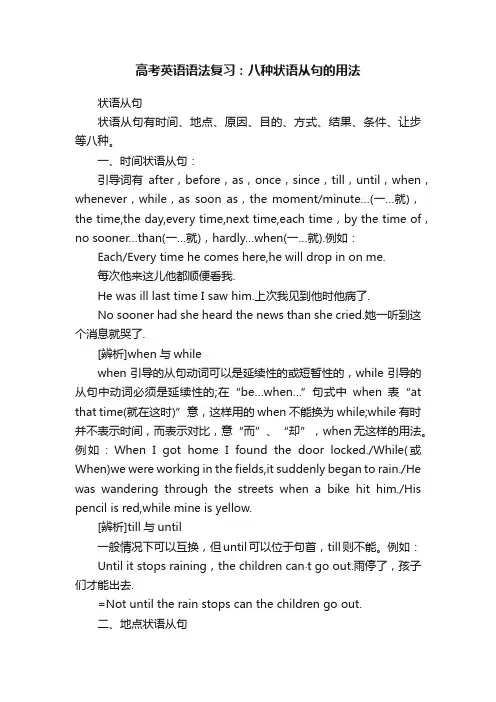
高考英语语法复习:八种状语从句的用法状语从句状语从句有时间、地点、原因、目的、方式、结果、条件、让步等八种。
一、时间状语从句:引导词有after,before,as,once,since,till,until,when,whenever,while,as soon as,the moment/minute…(一…就),the time,the day,every time,next time,each time,by the time of,no sooner…than(一…就),hardly…when(一…就).例如:Each/Every time he comes here,he will drop in on me.每次他来这儿他都顺便看我.He was ill last time I saw him.上次我见到他时他病了.No sooner had she heard the news than she cried.她一听到这个消息就哭了.[辨析]when与whilewhen引导的从句动词可以是延续性的或短暂性的,while引导的从句中动词必须是延续性的;在“be…when…”句式中when表“at that time(就在这时)”意,这样用的when不能换为while;while有时并不表示时间,而表示对比,意“而”、“却”,when无这样的用法。
例如:When I got home I found the door locked./While(或When)we were working in the fields,it suddenly began to rain./He was wandering through the streets when a bike hit him./His pencil is red,while mine is yellow.[辨析]till与until一般情况下可以互换,但until可以位于句首,till则不能。
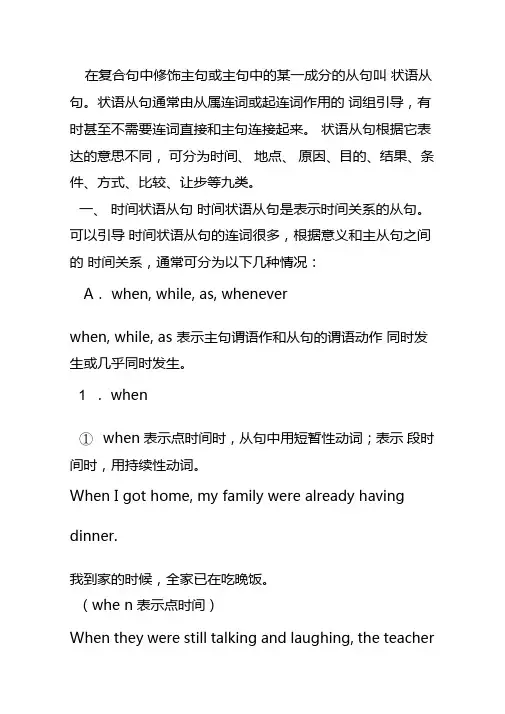
在复合句中修饰主句或主句中的某一成分的从句叫状语从句。
状语从句通常由从属连词或起连词作用的词组引导,有时甚至不需要连词直接和主句连接起来。
状语从句根据它表达的意思不同,可分为时间、地点、原因、目的、结果、条件、方式、比较、让步等九类。
一、时间状语从句时间状语从句是表示时间关系的从句。
可以引导时间状语从句的连词很多,根据意义和主从句之间的时间关系,通常可分为以下几种情况:A.when, while, as, wheneverwhen, while, as 表示主句谓语作和从句的谓语动作同时发生或几乎同时发生。
1 .when①when表示点时间时,从句中用短暂性动词;表示段时间时,用持续性动词。
When I got home, my family were already having dinner.我到家的时候,全家已在吃晚饭。
(whe n表示点时间)When they were still talking and laughing, the teachercame in.当他们还在说笑的时候,老师进来了。
(when表示段时间)He waved a hello when he saw her.当他看见她的时候,就挥手打了个招呼。
(when表示点时间)When you think you know nothing, you begin to know something. 当你认为自己一无所知的时候,就开始知道一些事情了。
(when表示段时间)注意:当when意思是正当...... 时候(and at that moment )时,when只能跟在前一分句之后。
He was about to go to bed whenthe doorbel rang. 他正要上床,忽然门铃响了。
They were watching the World Cup when suddenly the lights went out.他们正看着世界杯比赛,突然灯灭了。
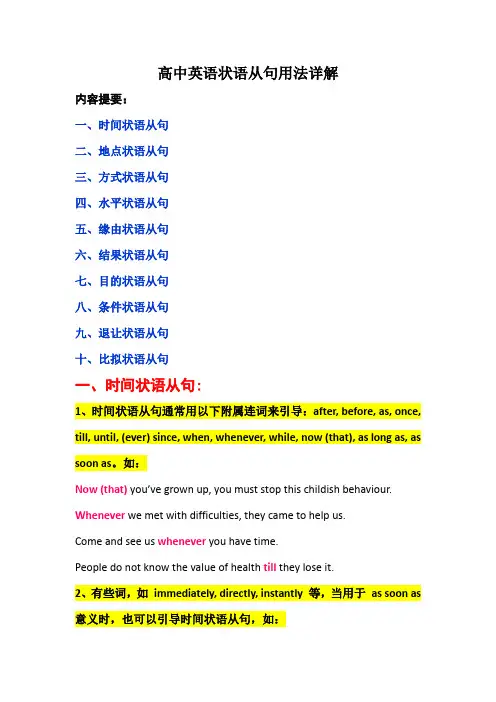
高中英语状语从句用法详解内容提要:一、时间状语从句二、地点状语从句三、方式状语从句四、水平状语从句五、缘由状语从句六、结果状语从句七、目的状语从句八、条件状语从句九、退让状语从句十、比拟状语从句一、时间状语从句:1、时间状语从句通常用以下附属连词来引导:after, before, as, once, till, until, (ever) since, when, whenever, while, now (that), as long as, as soon as。
如:Now (that)you’ve grown up, you must stop this childish behaviour. Whenever we met with difficulties, they came to help us.Come and see us whenever you have time.People do not know the value of health till they lose it.2、有些词,如immediately, directly, instantly 等,当用于as soon as 意义时,也可以引导时间状语从句,如:I got in touch with him immediately I received his letter.My sister came directly she got my message.The machine will start instantly you press the button.I’ll telephone you directly I hear the news.Will you look for it immediately you get there?3.某些表示时间的名词词组,如the (very) moment ( = as soon as ), the minute ( = as soon as ), the instant ( = as soon as ), the day, the year, the morning, every time, each time, next time, the first time 等,也可以引导时间状语从句,如:I’ll tell you about it the moment you come.I started the instant I heard the report.The instant she saw him she knew he was her brother.Every time I catch a cold, I have pain in my back.I’m going to see him next time he comes to Shenzhen.He left Europe the year World WarⅡbroke out.He had impressed me that way the first time I met him.I started the very moment I got your letter.I’ll tell him the minute (that) he gets here.4.有些关联附属连词,如no sooner …than / hardly …when / scarcely …when / barely …when 等,也能引导时间状语从句。
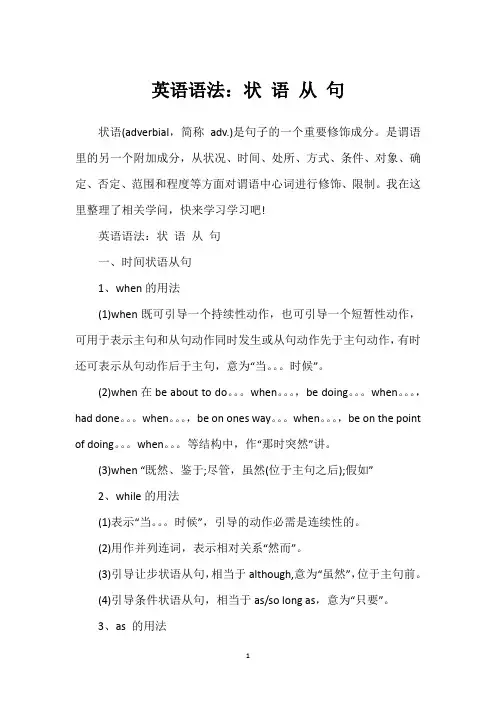
英语语法:状语从句状语(adverbial,简称adv.)是句子的一个重要修饰成分。
是谓语里的另一个附加成分,从状况、时间、处所、方式、条件、对象、确定、否定、范围和程度等方面对谓语中心词进行修饰、限制。
我在这里整理了相关学问,快来学习学习吧!英语语法:状语从句一、时间状语从句1、when的用法(1)when既可引导一个持续性动作,也可引导一个短暂性动作,可用于表示主句和从句动作同时发生或从句动作先于主句动作,有时还可表示从句动作后于主句,意为“当。
时候”。
(2)when在be about to do。
when。
,be doing。
when。
,had done。
when。
,be on ones way。
when。
,be on the point of doing。
when。
等结构中,作“那时突然”讲。
(3)when “既然、鉴于;尽管,虽然(位于主句之后);假如”2、while的用法(1)表示“当。
时候”,引导的动作必需是连续性的。
(2)用作并列连词,表示相对关系“然而”。
(3)引导让步状语从句,相当于although,意为“虽然”,位于主句前。
(4)引导条件状语从句,相当于as/so long as,意为“只要”。
3、as 的用法(1)表示“当。
时候”,强调同时发生,不指先后。
(2)说明两种正在进展或变化的状况,表示“随着”,表示时间的推移。
(3)表示“一边。
一边。
”。
(4)强调两个动作紧接着发生。
(5)表示“虽然,尽管”。
(6)其他含义“正如,正像”,“作为”,“由于,由于”。
4、before的用法(1)一般意为“在。
之前”“。
才”,“。
就”“还没有。
”“免得”“不知不觉”“宁可,宁愿”,“否则,要不然”。
(2)It + will be/was + 时间段+before+一般现在时/一般过去时。
在确定句中,意为“多长时间之后才”;在否定句中,意为“用不了多长时间就”。
5、until和till(1)与确定句连用,必需是连续性动词。
高中英语知识点归纳状语从句的类型和用法状语从句是英语语法中的一个重要知识点,广泛应用于句子中对主句的补充和修饰。
状语从句可以通过引导词或短语来表示不同的含义和用法。
本文将对高中英语中状语从句的类型和用法进行归纳总结。
一、时间状语从句时间状语从句用于表示主句发生的时间或顺序,并通过引导词“when”、“while”、“before”、“after”等来引导。
例如:1. When I was a child, I liked to play football.(当我还是个孩子时,我喜欢踢足球。
)2. She called her mother while she was cooking.(她一边做饭一边打电话给妈妈。
)3. Before you leave, please turn off the lights.(在离开前,请关灯。
)二、地点状语从句地点状语从句用于表示主句所发生的地点,并通常由引导词“where”来引导。
例如:1. I will meet you where we agreed.(我会在我们约定的地方见你。
)2. He found a quiet place where he could read in peace.(他找到了一个安静的地方,可以在那里安心阅读。
)三、原因状语从句原因状语从句用于表示主句的原因或解释,并通过引导词“because”、“since”、“as”来引导。
例如:1. He didn't go to school today because he was sick.(他今天没去上学,因为他生病了。
)2. Since it is raining heavily, we should stay indoors.(因为下大雨,我们应该待在室内。
)四、方式状语从句方式状语从句用于表示主句动作或状态的方式或方法,并通常由引导词“as”、“like”、“the way”来引导。
英语八类状语从句的用法归纳状语从句是句子中起状语作用的从句,用来修饰动词、形容词、副词或整个句子。
根据状语从句的不同用途,可以分为八类:时间状语从句、地点状语从句、条件状语从句、原因状语从句、结果状语从句、比较状语从句、目的状语从句和方式状语从句。
下面将对这八类状语从句的用法进行归纳。
一、时间状语从句时间状语从句用来表示主句中的动作发生的时间,常见的引导词有when(当.时候)、while(当.的时候)、before(在.之前)、after (在.之后)、since(自从)、until(直到)等。
例如:•I will call you when I arrive home.(当我到家时我会给你打电话。
)•She was reading a book while I was studying.(当我在学习时她在读书。
)•You should finish your homework before you go to bed.(你应该在睡觉前完成作业。
)二、地点状语从句地点状语从句用来表示主句中的动作发生的地点,常见的引导词有where(在哪里)、wherever(无论在哪里)等。
例如:•I will meet you where we agreed.(我会在我们约定的地方见你。
)•You can go wherever you want.(你可以去任何地方。
)三、条件状语从句条件状语从句表示主句中的动作发生的条件,常见的引导词有if(如果)、unless(除非)等。
例如:•If it rains tomorrow, we will stay at home.(如果明天下雨,我们会呆在家里。
)•I will not go to the party unless you invite me.(除非你邀请我,否则我不会去参加派对。
)四、原因状语从句原因状语从句用来表示主句中的动作发生的原因,常见的引导词有because(因为)、since(因为)、as(因为)等。
英语状语从句归纳总结状语从句是英语中非常重要的一种句子成分,它可以用来修饰动词、形容词、副词等,起到对句子进行修饰和补充说明的作用。
在英语写作和口语表达中,状语从句的使用频率非常高,因此对于学习者来说,掌握状语从句的用法和特点是非常重要的。
下面将对英语状语从句进行归纳总结,帮助大家更好地掌握和运用这一语法知识。
一、时间状语从句。
时间状语从句用来表示主句中的动作发生的时间,常见的引导词有when, while, as, before, after, since, until等。
例如:When I was young, I used to go fishing with my father.I will call you while I am on my way home.After she finished her homework, she went to bed.二、地点状语从句。
地点状语从句用来表示主句中的动作发生的地点,常见的引导词有where, wherever等。
例如:I will meet you where we first met.Wherever you go, I will follow.三、原因状语从句。
原因状语从句用来表示主句中的动作发生的原因,常见的引导词有because, since, as, for等。
例如:Because it was raining, we decided to stay at home.Since you are not feeling well, you should go see a doctor.四、条件状语从句。
条件状语从句用来表示主句中的动作发生的条件,常见的引导词有if, unless, provided that, as long as等。
例如:If it rains tomorrow, we will have to cancel the picnic.You can go out to play provided that you finish your homework first.五、方式状语从句。
英语中状语从句的意义及用法1. 状语从句在句子中起状语作用的从句叫做状语从句。
状语从句由从属连词引导。
状语从句可分为:时间状语从句:When Susan goes to town, she will visit her grandma.苏珊每次进程,总要去看望她奶奶。
地点状语从句:I will go where I am needed. 哪里需要我,我就到哪里去。
方式状语从句:I have changed it as you suggest. 我已经按照你的建议作了改变。
原因状语从句:Mary didn’t go shopping because I advised her not to.玛丽没有去购物,因为我劝她不要去。
目的状语从句:They worked hard in order that they might succeed.他们努力工作,以便能够获得成功。
结果状语从句:Waste must be treated so that it does not become a danger to life.废物必须进行处理,这样它才不会成为危害生命的东西。
条件状语从句:If he works hard, he will surely succeed. 如果努力工作,他肯定会成功。
让步状语从句:Though we are all different, we need never be separate.比较状语从句:I was happier than I had ever been in my life. 这是我一生中最快乐的时光。
2. 时间状语从句:after时间状语从句由下列连词引导:After, as, before, once, since, till, until, when, whenever, while, as soon asLet's wait till the rain stops. 咱们等到雨停再说吧。
英语语法状语从句的归纳总结Ability is not the only criterion, but character is the criterion.英语语法状语从句的归纳总结在复合句中修饰主句或主句中的某一成分的从句叫状语从句..状语从句通常由从属连词或起连词作用的词组引导;有时甚至不需要连词直接和主句连接起来..状语从句根据它表达的意思不同;可分为时间、地点、原因、目的、结果、条件、方式、比较、让步等九类..一、时间状语从句时间状语从句是表示时间关系的从句..可以引导时间状语从句的连词很多;根据意义和主从句之间的时间关系;通常可分为以下几种情况:A.when; while; as; wheneverwhen; while; as表示主句谓语作和从句的谓语动作同时发生或几乎同时发生..1.when①when表示点时间时;从句中用短暂性动词;表示段时间时;用持续性动词..When I got home; my family were already having dinner.我到家的时候;全家已在吃晚饭..when表示点时间When they were still talking and laughing; the teacher came in. 当他们还在说笑的时候;老师进来了..when表示段时间He waved a hello when he saw her.当他看见她的时候;就挥手打了个招呼..when表示点时间When you think you know nothing; you begin to know something.当你认为自己一无所知的时候;就开始知道一些事情了..when表示段时间注意:当when意思是正当……时候and at that moment时;when只能跟在前一分句之后..He was about to go to bed when the doorbel rang.他正要上床;忽然门铃响了..They were watching the World Cup when suddenly the lights went out.他们正看着世界杯比赛;突然灯灭了..They had just arrived home when it began to rain.他们刚到家;天就开始下雨了..②有时when表示虽然;尽管的含义;相当于although或since..He walks when he might take a taxi.尽管可以打的;但他还是步行..How can you hope for mercy yourself when you show none既然你不宽恕别人;你自己又怎能希望得到别人的宽恕呢2.while①while通常表示一段时间;从句中宜用持续性动词作谓语..Strike while the iron is hot.趁热打铁..She fell asleep while she was reading the newspaper.她在看报的时候睡着了..②while有时可以作并列连词;表示对比;可译成……而……..I am fond of English while he likes maths.我喜欢英语而他却喜欢数学..We slept while the captain kept watch.我们睡觉而上尉担任警戒..③while有时可引导让步状语从句;意思是虽然..While they love te children; they are strict with them.虽然他们都爱他们的孩子;但却对他们要求严格..提示:虽然during 与 while 意思很相近;但是during是介词;不能引导从句.. 3.as①as表示点时间时;从句中用短暂性动词;表示段时间时;用持续性动词..as和when两者经常可以通用..The thief was caught as when he was stealing in thesupermarket.小偷在超市行窃时被逮住了..I saw Jim as when he left the meeting room.吉姆离开会议室时候我看到了他..②as表示一边……一边……;强调从句和主句中两个动作交替进行或同步进行..They talked as they walked.他们边走边聊..He looked behind from time to time as he went.他一边走;一边不时地往后看..③as表示随着As time goes on; it's getting warmer and warmer.随着时间的推移;天气变得越来越暖了..As spring warms the earth; al flowers begin to bloom.随着春回大地;百花开始绽放..4.when; while; as的用法区别①只有当从句表示的是段时间;即其谓语动词有持续性特征时;这三者可以通用互换..I got the news on the radio when while as I was having breakfast.我在吃早饭的时候从收音机里获悉这一消息..②在下列情况下;三者彼此之间不能替换使用:a.as更强调同一时间或紧接的一前一后或伴随着的变化..We listened to the singer sing as he played the guitar.我们听着歌星边弹吉它边演唱..I thought of it just as you opened your mouth.你一张嘴我就知道你要说什幺As he grew older; he became less and less active随着他年龄的增长;他变得越来越不活泼了..提示:状语从句可放在主句之前或之后;放在主句之前时一般用逗号与主句分开..有时可置于主句中间;前后用逗号..b.when更强调特定时间;还可表示从句中的动作先于或后于主句的动作..When I had given Mary the spare ticket; I found my own already gone.当我把多余的票给了玛丽时;我才发现我自己的票已不知去向..从句动作发生在主句之前;注意主从句的时态When I finally got there; he meeting had been on for ten minutes.当我最终赶到那里时;会议已开始十分钟了..从句动作发生在主句之后;注意时态 c.while从句只能表示延续的动作或状态或主从句中动作的对比..She thought I was talking about her daughter; while in fact;I was talking about my daughter. 她以为我在谈论她女儿;而事实上;我在谈论我的女儿..d.若表示两个短促动作几乎同时发生时;用as场合多于when.. As he finished his speech; the audience burst into applause. 他结束讲话时;观众爆发出雷鸣般的掌声..5.whenever whenever是when的强势语;它描述的不是一次性动作;而是经常发生的习惯性动作..You are always welcome whenever you come.无论你何时来都欢迎..Whenever we met with diffiulties; they came to help us.每当我们遇上困难的时候;他们就来帮我们..B. before; after1.beforebefore表示在一段时间之前..I must finish all the work before go home.回家之前我必须干完所有的活..You must first learn to walk before you try to run.在想要跑以前;你得先学会走..He had learned English for three years before he went to London.他去伦敦之前已学了三年英语..提示:before 从句往往带有否定的含义..He ran off before I could stop him.我还没来得及阻止他;他就跑掉了..Take it down berore you forget it.趁着还没忘记的时候就记录下来..必背: before 常用句型 It is was will be beforeIt wil be five years before we meet again.五年以后我们才能再见..It will be not long before you regret what you have done.不用过多久你就会对你所作所为感到后悔的..It was not long before I realized I was wrong.不久我就意识到我错了..It was minutes before the police arrived.过了几分钟警察才到..2.afterafter表在一段时间之后..Let's play football after school is over.放学后我们踢足球吧..The sun came out soon after the storm stopped.暴风雨过后不久;太阳出来了..C.till; until1.untiltill用于肯定句时;表示直到为止;主句必须为持续性动词.. We shall wait until till he comes back.我们将一直等到他回来.. 注意它们的拼写Everything went well untiltill that accident happened.直到发生那意外之前;一切都正常..2. not untiltill表示直到才 ;主句通常要用短暂动词;这时until和till可用before代替..I didn't leave until till before she came back.直到她回来;我才离开的..Bells don't ring till until you strike them.铃不打不响..Peopl do not know the value of their health till until before they lose it. 人们直至失去了健康才知其可贵..3.当not until位于句首时;主句中的主语、谓语要使用倒装语序..Not until she stopped crying did I leave. 直到她不哭了;我才离开的..注意: until引导的从句可以放在主句之前或主句之后;但till从句一般不放在句首.. 4.在强调句型中一般只能用until;不用till.. It was not until she took off her drk glasses that Irecognized her.直到她摘下墨镜;我才认出她..D.since; ever since1.since自……以来..表示动作从过去某一点时间一直延续到说话时间为止..主句中通常为延续性动词的现在完成时;since从句中一般用短暂性动词的一般过去时..It has been just a week since we arrived here.我们到这儿刚刚一星期..Where haveyou been since I last saw you自上次我见过你之后;你去了哪里Since she was young; she has been collecting stamps.她自年轻时起就一直集邮至今..提示:有时since 从句中也可以用延续性动词;注意它的译法..Tom is now working on the farm.It's two years since he was a college student.汤姆现在农场上班;他大学毕业已有两年了..2.ever since 从那时起直至现在;此后一直..表示说话者强调主句动作或状态持续时间长;语气比since强..Ever since they got married in 1950; they have lived happily.自一九五零年结婚以来;他们一直生得很幸福..3.since还可以用作副词或介词..The big clock was damaged during the war and has been sienteversince.这只大钟在战争中损坏了;从此就一直不响了..My uncle went to Tibet in the 1950s. He has been living thereeversince.我叔叔五十年代就去了西藏;从那以后他一直生活在那里..You have made great achievements in your work since graduation. 你们自毕业以来已经在工作中取得了巨大成就..E.as soon as as soon as...可译为一……就……;用来表示主从句的动作是紧接着发生的.. He will come and see you as soon as he can.他一有空就来看你..He rushed home as soon as he got the good news.他一得到这个好消息就奔回家..必背:一……就……还可以用onupon doing 结构来表示..On arriving home he called up Lester. = As soon as he arrived home; he called up Lester. 他一到家就给莱斯特打电话.. F. immediately instantly directly 相当于as soon as;从句中用一般过去时态..They phoned her immediately they reached home.他一到家马上就给她打了电话..I recognized her instantly I caught a glimpse of her.我一看见她就把她认出来了..We came directly we got your telephone.我们一接到你的电话就赶来了..G.the moment; the minute; the instant; the second 这几个名词短语也可用作连词;直接引导时间状语从句;表示一…就… ..He said he'd turn on TV th moment he got home.他说他一到家就打开电视机..Tell him I need to see him the minute he arrives.告诉他;他一到我就要见他..The second the bell rang; the students rushed out of the classroom.铃一响;学生就冲出了教室..H.hardly scarcely when; no sooner than这两个短语都表示刚……就……;可以互换;主句通常用去完成时..He had no sooner started out than he felt homesick.他刚出发就想起家来..He had hardly started his speech when someone rose to refute his points.他刚开始发言;就有人站起来反驳他的论点..注意:当hardly; scarcely; no sooner 位于句子的开头时;主句须用倒装语序..Hardly had she fallen asleep when a knockat the door woke her up.她刚要睡着;忽然敲门声把她吵醒..No sooner was the frost off the ground than the work began. 地上的霜一消散;人们就开始工作了..I.once once作连词时;也相当于as soon as;但它含有的条件意味更浓;它引导的从句较短..Once you begin; you must continue.一旦开了头;你就应当继续下去..Once you see him; you will neer forget him.你一旦见过他;就不会忘了他的..J.next time; the first time; the last time; every time 等Be sure to call on us next time you come to town.下次你进城一定来看我们..He left me a good impression the first time I met him.我第一次见他时;他给我留下了好印象..Every time I see him he looks miserable.我每次见到他;他都是一付痛苦的表情..The last time I spoke to Bob; he seemed happy enough.上一次我见到他时;他看上去很开心..K.by the time by the tine 也可以引导时间状语从句;意为到时为止;主句一般要用完成时态..By the time he was fourteen; Einstein had learned advanced mathematics all byhimself.爱因斯坦到十四岁时就自学完了高等数学..从句为一般过去时;主句要用过去完成时I shall have finished my work by the time you return.在你回来之前我将会做完我的活儿..从句为一般现在时;主句要用将来完成时二、地点状语从句地点状语从句通常由where; whereverwhere的强势语和everywhere引导;是表示空间关系的状语从句..A. wherewhere 在……地方;去……地方Wuhan lies here the Yangtze and the Han River meet.武汉位于长江和汉水汇合处..Where there is a will; there is a way.有志者;事竟成..I found my books where I had left them.我的书在我原来放的地方找到了..You'd better make a mark where you have any questions.哪儿有问题;你最好在哪儿做个记号..这里where引导的从句不是定语从句注意:在地点状语从句之前;不要使用介词..误You should put the book at where it was.正You should put the book where it was.你应该把书放在原来的地方..误We should go to where we are needed most.正We should go where we are needed most.我们应该到最需要我们的地方去..B.whereverwherevr在任何……地方;无论哪里Wherever you go; you should do your work well.不论到什么地方;都要把工作做好..You may sit down wherever you like.你爱坐哪儿就坐哪儿..C.everywhereEverywhere they went; they were kindly receivd.他们每到一处都受到了友好的接待..三、原因状语从句原因状语从句是表示原因和理由的从句..引导原因状语从句的有as; because; since; now that; considering that; seeing that等.. A.becausebecause因为Because I like it; I do it.因为我喜欢;所以我才干..He couldn'thave seen me; because I was not there.他不可能见过我;因为当时我不在那儿..比较: because 和for的区别..1.for 是并列连词;只用于连接表示原因的分句;因此不能用于句首..because表示原因时;可位于句首..误For he did not obey the rules; he was punished.正Because he did not obey the rules; he was punished.由于他不遵守规章制度;他受到了处..2.for 表示的是推断解释;because强调动作发生的直接原因..It must have rained last night; for the ground is wet.昨晚肯定下雨了;因为地面是湿的..不可用because;因为地面湿不是天下雨的原因The day breaks; for the birds are singing.天亮了;因为鸟在叫..不可用because;因为鸟叫不是天亮的原因He went to bed early; because he was tired由于他累了;所以他很早就上了床..直接的理由He must be tired; for he went to bed early.他肯定累了;因为他很早就上了床..间接的推断3.在强调结构It iswas that和关联词not but 引导的原因状语从句中;宜用because..It's because he helped you that I'm prepared to help him. 正是因为他帮助过你;所以我乐意去帮助他..He decided to give up thechance of going abroad; not because he did not want to but because his wife was ill.他决定放弃出国的机会;不是因为他不想去;而是因为他妻子病了..B. since since 因为;既然..引导的从句大多置于句首;主从句的时态一般相同..Since you have no licence; you are not allowed to drive.因为你没有驾驶执照;所以不允许你开车..Since you are al here; let's try and reach a decision.既然大家都来了;咱们就设法做出一个决定吧..C.as as 由于..一般多用于句首..As she was ill; she didn't come to the party.由于病了;她没来参加晚会..As he was not well enough; I had to go without him由于他身体欠佳;我只好不带他去了..As it rained; we all stayed at home.由于下雨我们都呆在家里..C. because; since; as 的区别1.because语气最强;表达的是未知的新信息;一般置于主句之后;也可以放在主句之前;用逗号隔开..在回答why引导的特殊疑问句时;或在强调结构It iswas that 和关联词not but 引导的原因状语从句中;要用because..另外;because还常和副词just; merely等连用.. 2.since 往往表示的是已知的客观事实;或分析后的推理;引导的从句大多置于句首;主从句的时态一般相同..3.as 表示的理由最弱;只是对主句的附带说明;重点在主句..as从句通常放在主句前.. Just because he doesn't complain; you mustnot suppose that he is satisfied.你不可只因他不抱怨就以为他满足了..You shouldn't get angry only because some people speak ill of you.你不该仅仅因为有些人说了你的坏话就生气..Since you're not interested; Iwon't tell you about it.既然你不感兴趣;那我就不告诉你了..As you are unable to answer perhaps we should ask someone else. 因为你不能回答;也许我们该问一问别的人..注意: because等词不能与 so连用..误Because he was careless; so he failed in the exam.正Because he was careless; he failed in the exa.由于他粗心;所以他考试不及格..正He was careless; so he failed in the exam.由于他粗心;所以他考试不及格..E.now that now that 既然;因为..that可以省略..Now that dinner is ready; go and wash your hands.既然饭已好了;洗手去吧..Now you mention it again; I do remember.既然你又提起此事;我倒回想起来了..F.conidering that; seeing that 这两个词和since; now that意思相近;都有鉴于…事实;考虑到…. 的意思..Seeing that quite a few people were absent; we decided to put the meeting off.由于好些人都没到会;我们决定延期开会..seeing 后面的that可以省略Considering that they are just beginners; they are doing quite good job.考虑到他们才刚刚学做;他们干得算很不错的了..G.not that but that 这一结构相当于汉语的不是因为…而是因为…Not that I don't like the film; but that I have no time for it. 不是因我不喜欢看这部电影;而是因为我没有时间看..状语从句二四、目的状语从句目的状语从句是表示行为目的的从句..引导目的状语从句的主要连词有that; so;so that; so that; in order that等;从句中常常使用一些情态动词;如can; could; may; might; should等..A.that; so that;in order that表示为了;以便;一般放在主句之后..that语气较弱;用的较少;多用so that..Let's take the front seats that we may se more clearly.我们坐前排吧;这样我们可以看得更清楚些..Man does not live that he may eat; but eats that he may live. 人生存不是为了吃饭;而吃饭是为了生存..They hurried so that they might not miss the train.他们为了不误火车;才急急忙忙的..In order that everyone present might hear her clearly; she raised her voice again.为了使在场的每个人都能听清楚;她再次提高了声音..注意:当主从句的主语一致时;so that和in order that引导的目的状语从句可以转换成相对应的动词不定式结构..We got upearly so that we would arrive in time.为了能及时赶到;我们起得很早..They hurried so that they might not miss the train. → They hurried so as not to miss the train.他们为了不误火车;才急急忙忙的..Betty saved money in order that she could uy a portable computer. → Betty saved money in order to buy a portable computer.贝蒂存钱是为了买一台手提电脑..B.in case; lest; for fear that 几个短语都表示万一;惟恐;含有否定的意义..Better take more clothes in case the weather is cold.最好多带些衣服以防天气会冷..Take an umbrella in caseit rains.以防下雨;带把伞..五、结果状语从句结果状语从句是表示事态结果的从句..引导结果状语从句的连词有:that; so that; so that; such that等..结果状语从句通常置于主句之后..A.so; that; so that这三个词都可以引导结果状语从句..so that最为常用;so或that常用于口语或非正式文体中..What has happened tha you look so worried发生了什幺事;使你显得如此担心I didn't plan the work well; so thatso I didn't finish it in time.我没把工作计划好;结果没按时完成..so that从句常用逗号与主句隔开The room was packed with people; so that we couldn't get in. 房间里挤满了人;我们进不去..C. so...that so...that 如此……以致……..其引导的果状语从句有如下四种结构:1.so + 形容词副词 + that-从句The village is so small that it cannot be shown in the map. 这村子太小;所以这地图上没有..The wind was so strong that we could hardly move forward.风刮得那么大;我们简直寸步难行..2.so + 形容词 + aan + 单数名词 + that-从句It was so hot a day that tey all went swimming. 天是那么的热以致他们都去游泳了.. He made so inspiring a speech that everybody got excited.他发表了如此鼓舞人的演讲以致大家都很激动..3.so + manyfew +复数名词+ that-从句I have had so many falls that I am black and blue all over. 我摔了许多跤;以至于浑身青一块;紫一块..He has so few friend that he often feels lonely.他朋友很少;所以经常感到孤独..4.so + muchlittle +不可数名词 + that-从句I had so little money then that I couldn't even afford a used car.我当时囊中羞涩;甚至连一辆二手车都买不起..He drank so much wine last night that he felt terrible.昨晚他喝了那么多的酒;他觉得很不舒服..5.在so + 形容词副词 + that-从句结构中;如将so + 形容词副词位于句首;主谓语要倒装..So excited was he that she could not say a word.他很激动;一句话都说不出来..So loudly did he speak that even the people in the next room could hear him.他说得很响;连隔壁的人都能听见..D. such... that such...that 如此……以致……..其引导的结果语从句有如下四种结构: 1.such + aan + 形容词 + 单数可数名词 + that-从句Jenny is such a clever girl that all of us like her very much 詹妮是如此聪明的女孩;以至我们都非常喜欢她..We left in such a hurry that we forgot to lock the door.我们走得匆忙;把门都忘了锁了..2.such + 形容词 +复数名词+ that-从句He gave suchimportant reasons that he was excused.他说出了这么重要的理由;得到大家的谅解..They are such interesting novels that all of us want to read them.这些是十分有意思的小说;大家都想看..3.such + 形容词 + 不可数名词 + that-从句He made such rapid progress that the teacher praised him.他的进步很快;老师表扬了他..H shut the window with such force that the glass broke.他关窗子用了那么大的劲;玻璃都碎了..提示:such+aan+形容词+单数名词结构可以和so +形容词+aan+单数名词结构互换..He told us such a funny story that we all laughed. → He told us so funny a story that we all laughed.他给我们讲了一个如此有趣的故事;大家都笑.. →The story he told us was so funny that we all laughed. 他给我们讲的故事是如此有趣;大家都笑了..E. such that such that可以连用;意思是是这样...以致..Mother's answer was such that she didn't say yes and shedidn't say no.妈妈的回答就是这样;既没有同意也没有不同意..His anger was such that he lost control of himself. 他勃大怒;以致不能自制..比较:such ...that ... 引导的是结果状语从句.. such ...as ...引导的是定语从句请参考第10章定语从句..She had such a fright that she fainted.她吓得昏了过去..Luckily such earthquakes as can cause a lot of damage do no happen very often.很幸运;这种破坏性很大的地震并不经常发生..关系代词as在定语从句中作主语六、条件状语从句..条件状语从句是表示主句动作发生的前提或条件的从句..条件状语从句分为真实条件状语从句和非真实条件状语从句见第3章..引导条件状语从句的有if; unless; so as long as; as so far as; on condition that; in case; suppose; supposing等..条件状语从句中的谓语动词一般要用现在时或过去时代替一般将来时或过去将来时A.if if表示正面条件;意为如果..If you ask hm; he will help you.如果你向他请求;他会帮助你..Difficulties are nothing if we are not afraid of them.如果我们不怕困难;困难就算不了什么了..If I do not understand what he says; I always ask him.我不懂他的话时; 总是去问他..if = when比较: if only和only if的对比.. if only 解释但愿;要是……就好了;表示一个不可能实现愿望;要用虚拟语气.. only if 解释只有;等于only on condition that;从句用陈述语气..Only if you heat ice; it turns to water.只有当你给冰加热;它才会变成水..If only I knew要是我知道该多好..B.unless unless = if not; 表示反面条件;意思是如果不、除非.. They will go tomorrow unless it rains.除非明天下雨;否则他们会去的..They will go tomorrow if it doesn't rain.I won't let you in unless you show me your pass.如果你不出示通行证;我就不让你进来..= I won't let you in if you don't show me your pass.注意: if...not和unless通常是可以换用的..但在下列情况下;两者是有区别的:1.unless多引导真实条件句;if not可以引导真实条件句或非真实条件句..Hewon't be able to pass the final exams unless he works hard. 除非他努力;否则就通过不了期末考试..He won't be able to pass the final exams if he doesn't work hard.如果他不努力;就通过不了期末考试..He would pass the final exams if he worked hard.要是他努力的话;他就会通过考试..非真实条件句..含义是Hedoesn'twork hard.2.如果主句描述的是情感或情绪活动方面的内容;if not结构不能换成unless..如:I'll be quite glad if she doesn't come this evening.她今晚如果不来我很高兴..3.unless引导的状语从句可用否定结构;而if not引导的从句不可再用否定结构..Don't ask me to explain again unless you really don't understand.不要再叫我解释了;除非你真的不懂..4.uless能作为介词使用;相当于except;而if not不可以.. Nothing will come out of it unless disaster.这种事除非引起灾祸之外不会有什么结果..C.so long as; as long as; on condition that 这几个短语意思差不多;都表示只要;条件是……..AsSo long as we don't lose heart; we'll find a way to overcome the difficulty.只要我们灰心;我们就能找到克服困难的方法..You may use the room on condition that so long as you cleanit afterwards.只要你用完后打扫干净;你就可以使用这个房间..D.in case in case 既引导目的状语从句;也可以引导条件状语从句;等于if it happens that..In case I forget; please remind me of my promise.如果我忘了;请提醒我所做的承诺..Send s a message in case you have any difficulty.万一你有什么困难;请给我们一个信儿..E.providing; provided that; supposing; suppose that; given that 这几个短语意思相近;有如果;只要;假如等意思..Given that they are inexperienced; they've done a good job. 考虑到他们缺乏经验;他们的工作已做得很好了..that可以省略rovided Providingthatwe invite him; he would surely come to dinner.假如我们邀请他的话;他肯定会来吃饭的..SupposeSupposing we can't get enough food; what shall we do 假设我们弄不到足够的食物;那我们怎幺办仅用于疑问句七、方式状语从句方式状语从句是描述动作方式的从句..方式状语从句常由as; as if as though等词引导;通常位于主句之..A. as; just as 这两个连词的意思是如……;正如……一样..just as 比as 语气要强一些..Do in Rome as the Romans do.入乡随俗..Leave things as they are.让一切顺其自然..Please do as you are told.请按照人家告诉你做的去做..也可说Please do as told.Balloons float in the air just as boats do on the sea.气球在空中就如同船浮在海面上一样..注意:在口语中;还可用like来代替as;引导一个方式状语从句.. She is doing the work exactly like I want her to她正在完全按照我要她的那样在做这项工作..Do you make bread like you make cakes你做面包的方法是不是和做点心一样B.as if; as though 由as if 或as though引导的状语从句可以用陈述语气表示可能符合事实的情况;也可以用虚拟语气的过去式表示现在不符的或与事实相反的情况见第3章虚拟语气..She looks as if she is ill.看上去她好象是生病了..The boy plays piano as though he has a natural ear for music. 这孩子弹起钢琴来家好象天生很懂音乐似的..。
一、概说状语从句即指在主从复合句用作状语的从句。
按照其意义,状语从句可分为时间状语从句、地点状语从句、原因状语从句、目的状语从句、结果状语从句、条件状语从句、让步状语从句等。
学习状语从句主要应注意引导状语从句的从属连词的用法与区别,以及从属连词在一定的语言环境中的意义与用法。
二、时间状语从句壹、普通类从属连词引导时间状语从句的普通类从属连词有when(当……时),while(在……期间),as (当……,一边……一边……),before(在……之前),after(在……之后),since(从……以来),till/until(直到),whenever(无论何时),as soon as(一……就)等。
如:When I went into the classroom, he was reading. 当我走进教室时,他正在看书。
He read a newspaper as he went along. 他边走边看报纸。
We must strike while the iron is hot. 我们必须趁热打铁。
I will tell you after they leave. 于他们走后我再告诉你。
I told him to come back whenever he wants to.我告诉他什么时候想回来就回来。
I waited till/until she was back. 我一直等到她回来。
Once time is gone, you will never get it back. 时间一旦失去就再也得不到了注意:在时间状语从句中,不能用一般将来时、过去将来时态或将来完成时,而要用相应的一般现在时态、一般过去时或现在完成时来代替。
如:I’ll telephone you as soon as I get there.我一到达那里就打电话给你。
She said she would phone me as soon as she got there.她说她一到达那里就给我电话。
状语从句一、时间状语从句1、引导词:when, while, as(1)when的用法①既可以引导一个延续性动作,也可以引导短暂性动作可用于主从句动作同时发生,也可用于从句动作先于主句动作②可做并列连词,意为“那时,这时,突然”,相当于at this/that timeI was reading a novel when someone knocked at the door.还可以表示原因,意为“既然”;表条件,相当于ifHow can you hope to get mercy when you don’t show mercy on others?(when=if)③be doing when + did突然,意想不到的结果be about to do...when...我刚准备干...突然...had just done...when...我刚刚做完...突然...(2)while的用法①while引导必须是持续性的,侧重主从句动作同时发生Please don’t talk so loud while others are working.②可做并列连词,意为“而,却”,表对比While Tom was studing, Ted was playing computer games.③引导让步状语从句,意为“虽然”,相当于though, althoughWhile I accept that he is not perfect, I do actually like the person.(3)as的用法as引导延续性动作,主从句主语是相同的,多表示主从句动作同时发生意为“一边......一边......;随着”Jane sings as she works.2、引导词:as soon as, immediately, instantly, directly, the moment, the minute, once, no sooner... than..., hardly/scarecely...when...都意为“一......就......”,从句中用一般现在时代替将来时Once you remember it, you will never forget it.注意:no sooner......than......hardly............when......scarecely........when......↓↓用过去完成时一般过去时I had hardly got home when it began to rain.若把no sooner, hardly, scarecely放在句首,其后的句子要倒装No sooner had we arrived at the station than the train left.3、引导词:till, until, not...until...(1)肯定句:意为“某动作一直持续到某时间点才停止”“一直到......”Please wait until I come back.(2)否定句:意为“某动作一直到时间某点才开始”“直到......才......”He won’t go to bed till/until she returns.(3)till不可用于句首,而until可以Until you told me I had no idea of it.(4)not...until...句式的强调与倒装用法强调句:It be + not until + that + 主语+ 动词过去式It was not until you told me that I had any idea of it.4、引导词:before, since(1)若表达“还未......就......”“不到......就”“......才......”“趁......还没来得及”要用before We hadn’t run a mile before he felt tired.(2)It will be + 一段时间+ before sb. do sth. “多久之后才......”It will be half a year before I come back. It was (not)...before...“不久......就......”(3)since引导从句的谓语动词一般过去时,主句现在完成时/现在完成进行时She has been working in this factory since she left school.(4)在It is + 一段时间+ since 从句的句型中,时间计算一律从since从句的动作完成或结束状态时算It is three years since she was in our class.It was 3 years since he had lived there.他不住这儿已经3年了。
二、地点状语从句引导词:where, wherever(在任何地方)=no matter where(无论何处)The photo of mine was taken where stood the famous high tower.Wherever you go, you can see new facrories and stores.三、原因状语从句1、引导词:because, as(由于), since(既然), now that, seeing that, considering thatAs the weather was fine, I opened all the windows.2、for引导的并列句也可表原因,不可放在句首“因为......其原因是......”It must have rained last night, for the ground is still wet.3、介词短语because of, owing to, due to, thanks to等也表示原因Thanks to the bad weather, they put off the sports meet.四、条件状语从句引导词:if, unless(if...not), as long as, so long as(只要), in case(万一)As long as you understand the rule, you will have no futher difficulty.五、方式状语从句引导词:as, as if, as though(好像), just as, as...so...(正如,就像)Do just as you like.As A is to B, so C is to D. 正如......一样六、让步状语从句引导词:though, although, even if, even though, whether...or...(不管...还是...), whoever, whichever, however, whatever, whenever, no matter who, no matter which, no matter how, as(尽管), while(=though)Child as he is, he can do the work well.Though he is young, he knows...七、目的主语从句引导词:so that, in order that, for fear that(以免), in case, lest(免得,以防,唯恐)Come round to the windows so that I can see you.in order that 和so that的用法,从句中常有情态动词八、结果状语从句引导词:so that, so...that, such...that(如此...以至于), as a result(表结果), as a result of(表原因)用法如下:so + 形容词/副词+ that从句so + 形容词+ a/an + 可数名词单数+ that从句so + many/much/little/few + 名词+ that从句such + a/an + 形容词+ 可数名词单数+ that从句such + 形容词+ 可数名词复数/不可数名词+ that从句such + a lot of/lots of + 名词+ that从句It is such fine weather that we all want to go to the park.He earned so little money that he couldn’t support his family.当so和such置于句首时,主句要倒装So clever was he a student that he was able to work out all the difficult problems.九、比较状语从句引导词:as...as..., more...than..., than, less...than..., the more...the more..., the same...as, such...asHis name is the same as his father’s (name).Tom is as good a student as Jack. =Tom is such a good student as Jack.。